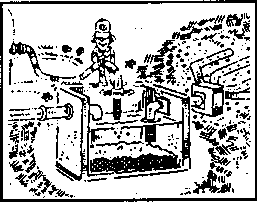|
Water used in homes, schools, businesses, and industries
must be cleaned or treated before it can be used again or returned
to the environment. No matter where you live, in an urban or
rural setting., the water you use does not just disappear: it
is piped to a treatment system. President George Bush and the
US, Congress proclaimed 1992 the Year of Clean Water. The treatment
of wastewater is important to keeping our water clean. This poster
depicts what happens to the water we all use, and how wastewater
is treated so that it can be used again. The poster is folded
into 8 1/2- by 11-inch panels; front and back panels can easily
be photocopied. A black and white version is available for coloring
by younger children.
Drawings on the left-hand side of the poster represent
the large city (urban and suburban areas) and drawings on the
right-hand
side of the poster represent small towns and
rural areas. In the city, the used water is piped through large underground
sewer
pipes to a community wastewater-treatment facility. At the wastewater-treatment
facility, the wastewater is treated by various processes, which
include grit chambers, sedimentation tanks, trickling filters,
and disinfection. The treated water then is reused or returned
to the environment.
In small towns and rural areas, several
alternative and individual onsite collection and treatment processes
are used
in treating wastewater. This poster depicts several processes,
which are: lagoons, wetlands, septic tanks and leach fields, and
sand filters.
This poster is the second in a series
of Water Education Posters designed to stimulate students' interest
in water resources.
Posters in the series can be joined to create a large wall mural,
Please see the Acknowledgments section for more information.
 |
Septic
Tank
The septic tank separates solids from liquids.
The solids (sludge)
collect on the bottom of the tank and are periodically pumped
out and disposed of at a community treatment facility or an approved
disposal site. The partially treated wastewater is piped to a
leach field. |
 |
Leach Field
Wastewater from the septic tank is piped to the leach field or
absorption field and seeps through the soil. The soil serves
as a filter, removing bacteria and nutrients from the wastewater.
The wastewater is purified by the microorganisms that live in
the soil. |
 |
Sand Filter
A system used in areas with high water tables, shallow
soils, or soils that water cannot flow through easily. Sand and gravel
are mounded on top of natural soil to filter wastewater received
from the septic tank before the wastewater reaches natural soil. |
 |
Lagoon
A treatment pond, usually 1 to 1.5 meters deep, that uses sun
algae, microorganisms, and oxygen to remove organic matter and
nutrients from wastewater. The resultant wastewater may be disinfected
by chlorine before being reused or released to the environment. |
 |
 |
|

